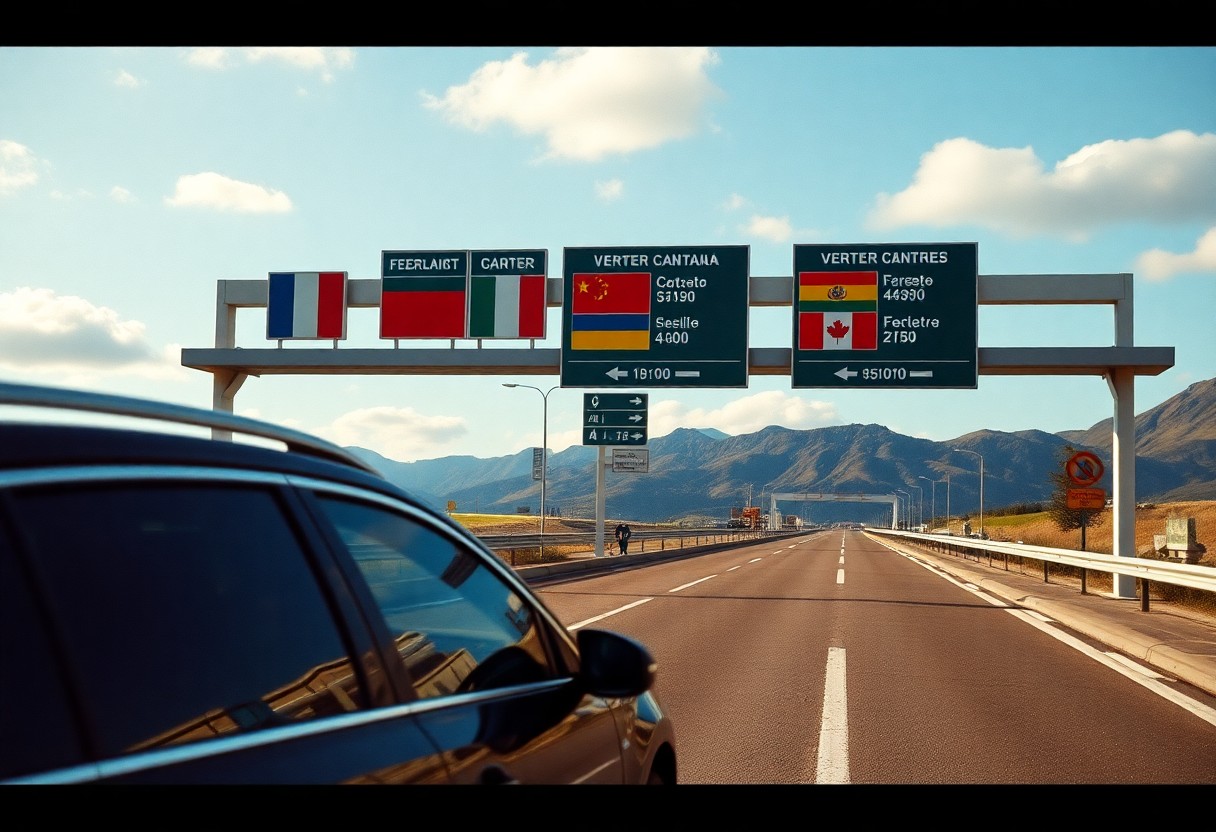Planning your European road trip with a rental car is fundamental to ensuring a seamless and enjoyable experience. This process includes meticulous route planning and a comprehensive understanding of cross-border regulations. Each rental company has its own policies regarding driving across different European nations. While most companies permit travel within Western European countries, there can be strict limitations on journeys to Eastern European nations. It is essential to meticulously review your rental agreement, as it will specify the borders you are allowed to cross, along with any associated fees. Before finalizing your reservation, confirm that your chosen rental provider allows travel to all your intended destinations, as breaching cross-border regulations can void your insurance and lead to hefty penalties. Therefore, acquiring detailed information on these restrictions is crucial for your European driving adventure.
Navigate the Essential Legal Requirements for Cross-Border Driving in Europe
Before you hit the road in your rental car across Europe, it is vital to meet specific legal obligations and requirements set forth by your rental company. Your rental agreement should clearly indicate that cross-border travel is permissible, in addition to confirming that you have adequate insurance coverage for all countries you plan to visit. Rental companies often impose regulations based on distinct European zones, and these rules can be particularly stringent for luxury vehicles. Thus, understanding these requirements is essential to avoid complications during your travels, ensuring a hassle-free experience.
Secure Your International Driving Permit (IDP) for European Driving
One of the most vital documents necessary for driving in Europe is the International Driving Permit (IDP). Obtaining this permit is a critical step and should be completed in your home country prior to your travel. The IDP acts as a complement to your regular driver’s license and is legally mandated in numerous European countries. By acquiring your IDP in advance, you can ensure compliance with local regulations and facilitate a smoother driving experience across various nations, making it an essential component of your travel preparations.
Understand Mileage Policies and Restrictions for Your Rental Car
When renting a car in Europe, many rental locations provide options for vehicles with unlimited mileage, which can be a significant benefit for travelers. However, it is crucial to recognize that border crossing fees apply, which can vary considerably, typically ranging from €5 to €47.60 per crossing, depending on the rental company and the countries involved. Moreover, due to insurance and security protocols, rental companies frequently impose specific restrictions based on vehicle categories. For instance, high-end brands such as BMW, Mercedes, and Audi often have more limited travel zones compared to standard models, emphasizing the importance of declaring your travel intentions in advance to avoid unexpected charges.

Comprehend Cross-Border Policies from Leading Rental Companies
When renting a car in Europe, it is essential to understand that each rental company enforces distinct cross-border policies. Major rental agencies typically permit travel between Western European countries, but you will discover that strict limitations apply for travel to Eastern Europe. Policies can vary significantly based on the vehicle type, with luxury cars often facing more restrictions compared to standard models. Gaining insight into these policies beforehand can guide you in making informed decisions regarding your rental choices and travel itinerary.
Examine Cross-Border Regulations from Avis and Enterprise
Avis and Enterprise are two rental companies that provide extensive coverage throughout Western Europe. Their vehicles can generally be driven in most EU countries, including popular travel destinations such as France, Germany, and Spain. However, it is crucial to note that both companies impose specific restrictions on luxury vehicles, particularly when driving into Italy. For example, Enterprise charges a daily cross-border fee of 5 euros, with a cumulative maximum charge of 50 euros. By familiarizing yourself with these fees, you can better budget for your journey.
Explore Cross-Border Driving Policies of AutoEurope and Hertz
Among the prominent rental providers, AutoEurope and Hertz implement specific country restrictions that are essential for travelers to comprehend. For instance, taking their vehicles into Eastern European nations such as Albania, Belarus, or Ukraine is typically prohibited. Additionally, Hertz restricts luxury vehicles and SUVs from entering Italy, while AutoEurope’s policies may differ based on their local partners. Therefore, it is critical to declare your travel plans to your selected provider before booking your rental vehicle. Your rental agreement will clearly outline the applicable cross-border fees, which vary by company and destination. For example, Hertz charges 47.60 euros for crossing from Germany to another authorized country, and you will likely need extra insurance coverage for international travel.
Awareness of Geographical Restrictions for Rental Cars
The rules governing cross-border travel with rental cars in Europe can differ significantly depending on the rental company and the type of vehicle chosen. Your rental agreement will clearly specify which countries you are authorized to visit with your rental vehicle. It is crucial to keep your rental company informed of your intended route, as crossing borders without appropriate permission can invalidate your insurance and lead to substantial penalties.
Identify Countries You Are Permitted to Drive In
Most rental companies allow you to drive freely within Western European countries, including France, Germany, and Spain. Zone 1 countries typically include EU member states in Western Europe, offering the greatest flexibility for your rental car use. Your rental agreement will provide a comprehensive list of all the permitted countries specific to your vehicle class, ensuring you fully understand your travel options.
Recognizing Restricted Territories for Rental Vehicle Travel
Countries that were once behind the Iron Curtain are often subject to travel restrictions. Most rental companies prohibit travel to Eastern European nations, including Albania, Belarus, Ukraine, and Russia, due to heightened risks and insurance challenges. Additionally, further limitations may be imposed on luxury vehicles and specific car brands. High-end vehicles like BMW, Mercedes, and other premium models frequently have stricter geographical limits. If your itinerary involves multiple countries, it is advisable to select a standard vehicle class to maximize flexibility and minimize potential fees or insurance complications.
Understand Vehicle-Specific Limitations for Rental Cars
While rental companies may have varying policies, most enforce strict regulations concerning which vehicle types are permitted to cross borders. Therefore, it is essential to check the specific limitations associated with your chosen vehicle class before making a reservation. These restrictions exist to protect valuable assets and ensure compliance with insurance requirements across different European regions.
Maximize Flexibility with Standard Rental Cars
Contrary to common misconceptions, standard rental cars offer the greatest flexibility for cross-border travel. Typically, you can drive standard vehicles across most Western European countries without needing special permits. However, you must inform your rental company about your travel plans and may need to pay cross-border fees that can range from 5 to 50 euros, depending on the situation.
Understand Restrictions on Luxury Vehicles for Cross-Border Travel
Significant restrictions apply to high-end vehicles regarding cross-border travel. Luxury cars often encounter notable limitations on border crossings, with brands such as BMW, Mercedes, and Audi frequently prohibited from entering Eastern European countries or Italy. In general, these luxury vehicles are confined to Zone 1 countries within Western Europe.
Furthermore, if you plan to rent luxury vehicles, expect higher security deposits and more stringent insurance requirements. Rental companies like Sixt and Enterprise impose restrictions on premium brands such as Jaguar, Maserati, and Porsche, allowing their use only in select Western European countries. For any border crossings, you will require special permission and possibly additional insurance coverage.
Plan Your Budget for Border Crossing Costs
When planning any cross-border trips in Europe with a rental car, it’s essential to maintain a clear budget. Most rental companies impose additional fees for crossing borders, even within the Schengen Area. It is crucial to inform your rental company of your intended route and secure written permission before crossing any borders to avoid unexpected charges.
Explore Typical Fees for Border Crossings
Border crossing fees in Europe typically range from €5 to €50, contingent on the rental company and specific circumstances. For instance, you’ll incur €47.60 with Hertz when crossing from Germany to another permitted country, while Enterprise charges €5 per day, capping at €50 for journeys originating in Germany. Being aware of these fees will help you effectively manage your finances during your travels.
Consider Potential Additional Charges
At certain borders, you may encounter extra insurance requirements and documentation fees. Your rental company might charge for special permits, especially when traveling to Eastern European countries or when utilizing luxury vehicles. Additionally, you should anticipate the possibility of higher insurance premiums for specific destinations, particularly in Italy or Eastern Europe. Keep in mind that some credit card insurance policies may not cover all European countries, necessitating the purchase of additional coverage from your rental company for complete peace of mind.

Mastering Ferry Travel with Your Rental Vehicle
Not all rental companies adhere to the same policies regarding ferry travel in Europe. While most companies permit ferry journeys, it is vital to confirm the specific rules associated with your rental. Crossing water borders often necessitates additional documentation and may incur extra fees that should be anticipated. Furthermore, your insurance coverage might shift when traveling by ferry, making it crucial to understand these factors.
Review Company-Specific Policies for Ferry Travel
Among leading rental companies, policies regarding ferry travel can vary significantly. Avis and Hertz generally allow ferry travel to authorized countries, but it is essential to verify destination restrictions in advance to avoid complications. On the other hand, Enterprise and Sixt may require pre-authorization and additional insurance for ferry crossings, which should be clearly outlined in your rental agreement to prevent misunderstandings.
Critical Considerations for Breakdown Coverage During Ferry Travel
Another vital aspect to contemplate is the vehicle breakdown coverage in the event of ferry travel. Most rental companies hold you responsible for vehicle repatriation costs if your car breaks down after a ferry crossing, which can amount to several thousand euros, depending on your location and the type of vehicle rented. This responsibility covers more than just mechanical failures; if you have an accident or the vehicle becomes unusable for any reason while on an island, you are liable for the costs associated with returning the vehicle to the original rental location. Some rental companies do provide additional insurance to cover these expenses, but it is crucial to purchase it before your journey to ensure adequate protection.
Strategize for Successful Cross-Border Driving with Rental Cars
When preparing to drive a rental car across European borders, thorough research and an understanding of your rental company’s specific rules are paramount. You may enjoy the freedom to cross borders in most European nations, but remember that each rental company has its own policies and fees that need to be acknowledged. The type of rental vehicle selected can significantly influence where you are allowed to travel, with luxury cars typically facing more restrictions than standard models. Always verify the countries you are permitted to visit, factor in any required border crossing fees, and review ferry travel regulations before embarking on your adventure. Careful examination of the rental agreement and obtaining an International Driving Permit will further equip you for a seamless journey. Your proactive planning is essential to avoiding complications at border crossings, ensuring a more enjoyable travel experience.
Commonly Asked Questions About Driving Rental Cars in Europe
Can I drive my rental car to any European country?
No, rental companies impose specific regulations concerning the countries you can visit. Most companies allow travel within Western European nations like France, Germany, and Spain. However, many restrict travel to Eastern European countries such as Albania, Belarus, and Ukraine. Luxury vehicles often have more stringent limitations. Always review your rental agreement for permitted countries before crossing any borders.
Are there additional fees for crossing borders with a rental car in Europe?
Yes, numerous rental companies impose border crossing fees. For instance, Hertz charges 47.60 euros for each border crossing from Germany, while Enterprise charges 5 euros per day (with a maximum of 50 euros) for trips starting in Germany. These fees apply even when traveling within the Schengen Area. It is imperative to inform the rental company about your travel itinerary and settle these fees before crossing any borders.
Is it allowed to take my rental car on a ferry between European countries?
Yes, most rental companies permit ferry travel provided your destination country is listed on their approved list. However, if your vehicle malfunctions while on an island, you will be responsible for the costs required to return the vehicle to its original rental location. Some companies, such as Hertz, offer coverage for ferry travel through their insurance options (CDW, TP, or SuperCover). Always verify the specific ferry policies stated in your rental agreement to avoid any surprises.
The Article: Is It Allowed to Drive a Rental Car Across European Borders? appeared first on https://rentacar24.org/
The Article Driving a Rental Car Across European Borders: Is It Allowed? Was Found On https://limitsofstrategy.com



Your insights on planning a European road trip really hit home for me! When I embarked on my journey through Europe last summer, I found that meticulous route planning made all the difference. I vividly remember standing at the stunning Cliffs of Moher in Ireland one minute and then exploring the bustling streets of Prague the next. However, it was the little details, like understanding the cross-border regulations, that saved me from potential headaches.
Your emphasis on understanding cross-border regulations is particularly timely, especially given the varying political landscapes in Europe. I recently experienced this while planning a trip through Eastern Europe; despite my usual meticulousness, I overlooked the specific policies of my rental company regarding certain countries. It was a real eye-opener to see how much the regulations can differ—not just in terms of which borders you can cross, but also regarding insurance implications and additional fees.
This post perfectly highlights some of the critical intricacies of planning a European road trip, especially the often-overlooked cross-border regulations that can greatly impact your experience. I remember planning my own journey across Europe a couple of years ago and faced a similar maze of regulations and logistics. Those details you mention about rental car policies are not just bureaucratic fine print; they can genuinely affect how smoothly the trip unfolds.